From antique to contemporary: at Venaria echoes of 17th- and 18th-century gardens intertwine with contemporary art interventions set in a vast complex rebuilt several times due to destructions and aesthetic evolutions.
The history of this site, featuring the largest garden of the House of Savoy in Piedmont, is long and troubled: in 1659 Amedeo di Castellamonte designed a single complex comprising a hunting lodge, a village, Italian-style formal gardens and hunting grounds (today’s Mandria Park). This layout survived until 1700, when the gardens were completely destroyed to create a new French-style system, realized by Henri Duparc and based on the project of a collaborator of André le Notre, who probably visited Venaria in 1679. During the Napoleonic era the park was completely converted into fields while the palace was used as barracks. Following the interventions carried out from 1998 to 2003 and later, the park has been partially reinstated (30 hectares out of 125). The unique quality of this site, besides its vastness, resides in the fact that it creates a harmonious balance between the antique original layout echoing in the recently reconstructed garden and the declaredly contemporary design interventions that are not only displayed artworks but elements of a cohesive composition: therefore the garden layout corresponds to the original project, while the three-dimensional features and the botanical selection are truly contemporary, as in theGiardino delle Rose where modern pergolas laden with climbing roses pay homage to the antique 18th-century “berceaux”. The Sala di Diana, the hall at the heart of the 17th-century palace, affords a perfect view on the large-scale garden layout: on one side – beyond the courtyard of honour – the eye is drawn eastwards along the great Via Maestra of the village; while westwards – beyond the parterre – it is led along a gallery lined by Corten steel walls retracing the antique avenue, all the way to the remains of the Temple of Diana. A clear trace of the 18th-century interventions is the large Citroniera: designed by Filippo Juvarra, in winter it was used to store hundreds of crates of citrus fruits, while today it has been converted into a location for major art exhibitions.
Highlights
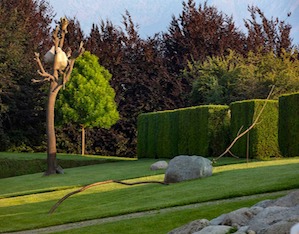
The Garden of Fluid Sculptures
This area is a project by contemporary artist Giuseppe Penone. Integrating metal, marble and nature itself, this installation creates an environment that is both rigorous and captivating, perhaps the most coherent of the entire complex.
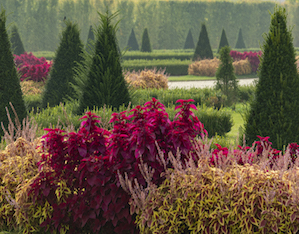
The Grande Galleria terraces
These terraces afford the best view on the Grand Parterre with boxwood hedges, pyramid-shaped sculpted yews, tidy lawns and hornbeam galleries echoing the original antique views. At the centre, a contemporary art installation by Giovanni Anselmo.
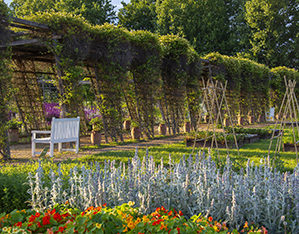
The Royal Potager Garden
Planted along the canal, this fruit and vegetable garden recreates the design of the original potager. Visitors can buy its produce.
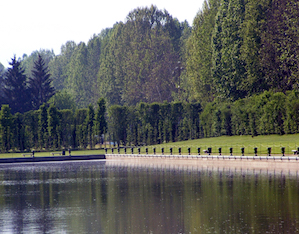
Fishpond
Rebuilt during restoration in keeping with the original 17th-century design, this Peschiera gives a sense of the grand scale of the Venaria complex, reflecting the entire palace in its waters.
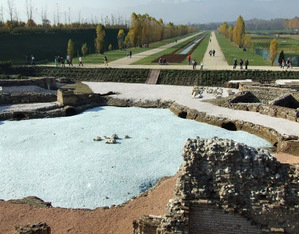
Fontana di Ercole
Formerly the centrepiece of the 17th-century garden this fountain dedicated to Hercules was demolished in the 18th century. Currently undergoing restoration, the fountain will see the reintegration of the original Hercules statue and casts of the other sculptures now disseminated in other in castles and villas across Piedmont.

The Park of La Mandria
Next to the Venaria gardens there is the large Park of La Mandria (over 3,000 hectares), the ideal setting for sport and recreational outdoor activities. Today property of the Region, during the 19th century this area was the hunting reserve of Victor Emmanuel III and his retreat where he would meet with Bela Rosin, his morganatic wife.
 Reggia di Venaria Reale
Contacts
Reggia di Venaria Reale
Contacts
Contacts
Telephone:+39 011 4992333
Address
Piazza della Repubblica 4
10078, Venaria Reale (TO)
 Reggia di Venaria Reale
Opening times and prices
Reggia di Venaria Reale
Opening times and prices
Opening hours
- Tuesday to Friday from 2.30 p.m. to 6.30 p.m.
- Saturdays, Sundays and holidays from 10.30 a.m. to 6.30 p.m.
- closed on December 25 and non-holiday Mondays
- Tuesday to Sunday from 10.30 a.m. to 6.30 p.m.
- closed on December 25 and non-holiday Mondays
Pricing
- Full price: € 20,00
- Reduced (Groups of min. 6, max. 15 people, as many as provided by Ridotti): € 16,00
- Reduced price under 21 (children from 6 to 20 years old) and university students under 26: € 10,00
- Schools (minimum classes of 12 students):€ 6,00 per student
- Children under 6: free admission
Ticket Gardens
- Full price: € 5,00
- Reduced (Groups of min. 6, max. 15, as many as Free): € 4,00
- Reduced price under 21 (children from 6 to 20 years old) and university students under 26: € 2,00
- Schools (minimum class size 12 students, free admission for 2 accompanying persons every 27 students): € 2,00
- Children under 6: free admission
Ticket Reggia Piano Nobile (allows to visit the Reggia and the gardens)
- Full price: € 14,00
- Reduced (Groups of min. 6, max. 15 people, as many as provided by Ridotti): € 10,00
- Reduced price for under 21 (children from 6 to 20 years old) and university students under 26 : € 8,00
- Schools (minimum classes of 12 students): € 5,00 per student
- Children under 6: free admission
For more information on the types of tickets and on the reductions consult the site.
 Reggia di Venaria Reale
How to get there
Reggia di Venaria Reale
How to get there
Address
Piazza della Repubblica 4
10078, Venaria Reale (TO)
Latitude: 45.138861
Longitude: 7.607263
How to arrive by road
Turin North ring road: exit Venaria or Savonera/Venaria. Car parks Castellamonte (park A) and Carlo Emanuele II (park B) Near via Castellamonte and viale Carlo Emanuele II, Turin North ring road, exit Venaria / “La Venaria Reale – Reggia e Giardini”.
How to arrive by train
Turin Dora-Ceres line (Venaria stop, viale Roma)
How to arrive by bus
- Dedicated GTT Venaria Express line: shuttle bus connecting the centre of Turin and Porta Susa station with the Reggia di Venaria and the Parco della Mandria.
- GTT buses: lines 72, 11, VE1
- CitySightseeing Torino, Linea C
How to arrive by bycicle
The Reggia di Venaria is included in the cycle path dedicated to the Royal Residences of Piedmont of the project called Corona Verde.
 Reggia di Venaria Reale
Services/Accessibility
Reggia di Venaria Reale
Services/Accessibility
Services
The Reggia di Venaria Reale allows you to organize and book guided tours.
- the costs of guided tours are in addition to those of the entrance fees
- reservations can be made from Monday to Friday, from 9.00 to 17.00
The Venaria Reale offers a wide choice of restaurants and cafes
- Dolce Stil Novo Restaurant
- Patio dei Giardini Cafeteria
- Argenti Cafeteria
Dogs are allowed to visit the Gardens if kept on a leash. Dogs are not allowed to enter the Park and the Mandria Castle.
On website of the Reggia di Venaria is active the online sales service where you can buy various types of products.
In the Reggia there are reserved seats for coaches.
Accessibility
Motor disabilities and strollers:
- The Reggia and the exhibition spaces are free of architectural barriers. Possibility of using electric means of locomotion, available to the public with motor difficulties, to facilitate the visit on the long outdoor routes. There are 3 wheelchairs available, to be requested at reception. Contact +39 011 4992302.
- materials can be downloaded from the website or available at the ticket offices. The visitor will be able to become familiar with the place, decreasing stress, difficulty in understanding and increasing involvement.
Visually impaired:
- a model of the Reggia, the Borgo and the Gardens is available and it is possible to tactilely explore some of the works and some of the stucco parts of the route through the Reggia. By their very nature, the Gardens offer a multisensory experience, enriched by the tactile exploration of Giuseppe Penone’s works. It is advisable to book the visit, for individuals the accompaniment is free by reservation.
Hearing impaired:
- hearing impaired visitors can book a visit with a LIS interpreter or a visit with a lip-reader guide. Information and reservations to +39 011 4992333
 Reggia di Venaria Reale
Private events
Reggia di Venaria Reale
Private events
The Reggia offers the possibility to rent its rooms for weddings and private events.
For further information please consult the website.
 Reggia di Venaria Reale
Itineraries
Reggia di Venaria Reale
Itineraries
You could find the garden in these itineraries
 Favorite saving result
Favorite saving result
 Warning!
Warning!
You've have to sign up or sign in to add this element to your favorites.
